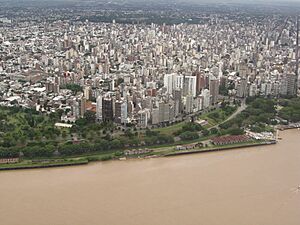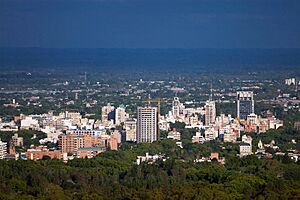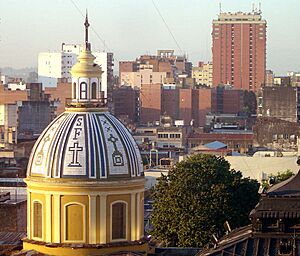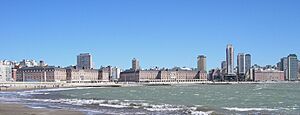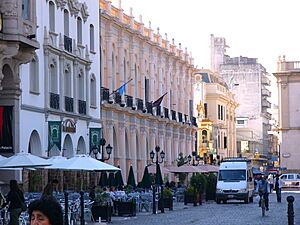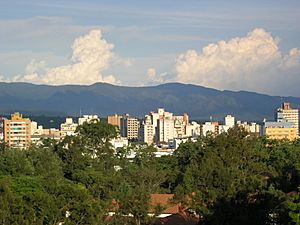List of cities in Argentina facts for kids
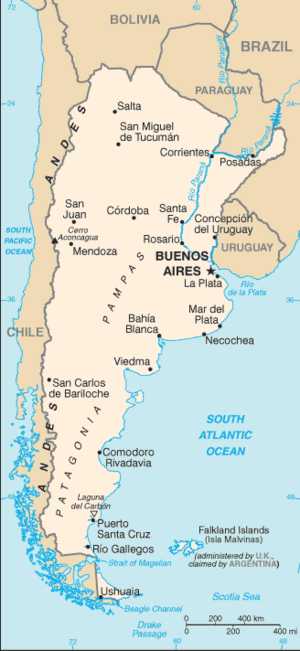

Argentina is a large country in South America, known for its amazing landscapes, delicious food, and vibrant culture. It has many different types of cities, from huge bustling centers to smaller, quieter towns. These cities are home to millions of people and play a big part in Argentina's economy and daily life.
Argentina's Biggest Cities
Argentina has several very large cities, often called metropolitan areas, where many people live and work. These cities are important centers for business, culture, and government.
Cities with Many People
The biggest cities in Argentina are home to over 150,000 people. The largest of them all is Buenos Aires, which is the capital city. It's a huge, exciting place with lots of history, beautiful buildings, and a lively arts scene. Other major cities include Córdoba, Rosario, and Mendoza. These cities are like busy hubs, offering many opportunities and attractions.
There are also many other cities in Argentina that are home to between 45,000 and 150,000 people. These cities are important regional centers, providing services and jobs for the areas around them. They often have their own unique charm and local traditions.
Cities by Province
Argentina is divided into 23 provinces, plus the autonomous city of Buenos Aires. Each province has its own capital city and many other towns and cities. Here's a look at some of the cities you can find in each province:
Buenos Aires Province
The Province of Buenos Aires surrounds the capital city of Buenos Aires. It's the most populated province in Argentina and has many important cities.
- La Plata is the capital of the province, known for its unique design and grand buildings.
- Mar del Plata is a popular coastal city, famous for its beaches and as a summer vacation spot.
- Bahía Blanca is a major port city in the south of the province.
- Other notable cities include Tandil, Pilar, and Necochea.
Catamarca
Catamarca is a province in northwestern Argentina, known for its mountains and dry climate.
- San Fernando del Valle de Catamarca is the capital city, located in a valley surrounded by mountains.
Chaco
Chaco is in the north of Argentina, known for its hot climate and natural areas.
- Resistencia is the capital, often called the "City of Sculptures" because of the many artworks found there.
- Presidencia Roque Sáenz Peña is another important city in the province.
Chubut
Chubut is a large province in Patagonia, famous for its wildlife and natural beauty.
- Rawson is the capital.
- Comodoro Rivadavia is the largest city in Chubut and an important center for oil production.
- Puerto Madryn is a coastal city, popular for whale watching.
- Trelew is a city with strong Welsh cultural roots.
Córdoba
Córdoba is located in the center of Argentina and is known for its universities and historic buildings.
- Córdoba is the capital and Argentina's second-largest city. It's a lively student city with a rich history.
- Villa Carlos Paz is a popular tourist town, especially in the summer, located by a lake.
- Río Cuarto is another significant city in the south of the province.
Corrientes
Corrientes is in northeastern Argentina, known for its wetlands and vibrant carnival celebrations.
- Corrientes is the capital city, located on the Paraná River.
- Goya is known for its annual National Surubí Fishing Festival.
Entre Ríos
Entre Ríos is a province between two major rivers, known for its hot springs and natural parks.
- Paraná is the capital, situated on the Paraná River.
- Concordia and Gualeguaychú are other important cities, with Gualeguaychú being famous for its carnival.
Formosa
Formosa is a northern province bordering Paraguay, known for its natural landscapes.
Jujuy
Jujuy is a mountainous province in the northwest, famous for its colorful hills and indigenous culture.
- San Salvador de Jujuy is the capital, nestled in a valley.
- Humahuaca is a historic town in the Quebrada de Humahuaca valley, a UNESCO World Heritage site.
La Pampa
La Pampa is a flat, agricultural province in the central part of Argentina.
- Santa Rosa is the capital city.
- General Pico is another important city in the province.
La Rioja
La Rioja is a dry, mountainous province in the northwest.
Mendoza
Mendoza is famous for its wine production and the Andes Mountains.
- Mendoza is the capital and a major wine-producing region, located at the foot of the Andes.
- San Rafael is another important city in the south of the province.
Misiones
Misiones is a subtropical province in the northeast, home to the famous Iguazu Falls.
- Posadas is the capital, located on the Paraná River.
- Puerto Iguazú is the gateway city to the magnificent Iguazu Falls.
- Oberá is known for its diverse immigrant communities.
Neuquén
Neuquén is a Patagonian province known for its lakes, mountains, and dinosaur fossils.
- Neuquén is the capital and the largest city in Patagonia.
- San Martín de los Andes and Villa La Angostura are popular tourist towns in the Andes.
Río Negro
Río Negro is another Patagonian province, famous for its fruit production and stunning landscapes.
- Viedma is the capital, located on the Río Negro river.
- San Carlos de Bariloche is a world-famous ski resort and adventure tourism hub in the Andes.
- General Roca and Cipolletti are important agricultural centers.
Salta
Salta is a beautiful northwestern province, known for its colonial architecture and diverse landscapes.
- Salta is the capital, often called "Salta La Linda" (Salta the Beautiful) for its charming old town.
- Cafayate is a wine-producing town in a scenic valley.
- Tartagal is a city in the northern part of the province.
San Juan
San Juan is a western province, known for its deserts, mountains, and growing wine industry.
- San Juan is the capital city.
San Luis
San Luis is a central province, known for its modern infrastructure and natural beauty.
- San Luis is the capital.
- Villa Mercedes is the second-largest city in the province.
- Merlo is a popular tourist destination in the mountains.
Santa Cruz
Santa Cruz is a large, sparsely populated Patagonian province, home to glaciers and vast plains.
- Río Gallegos is the capital and a major port city.
- El Calafate is the gateway to the Perito Moreno Glacier and Los Glaciares National Park.
- Caleta Olivia is an important oil and gas center.
Santa Fe
Santa Fe is a central province, important for agriculture and industry.
- Santa Fe is the capital, located on the Paraná River.
- Rosario is the largest city in the province and Argentina's third-largest city, a major port and industrial hub.
- Rafaela and Venado Tuerto are other significant cities.
Santiago del Estero
Santiago del Estero is one of Argentina's oldest provinces, located in the north.
- Santiago del Estero is the capital and one of the oldest cities in Argentina.
- La Banda is a city located across the Dulce River from the capital.
Tierra del Fuego
Tierra del Fuego is Argentina's southernmost province, including islands and parts of Patagonia.
- Ushuaia is the capital, known as the "End of the World" city, a popular base for Antarctic expeditions.
- Río Grande is an industrial city on the Atlantic coast.
Tucumán
Tucumán is Argentina's smallest and most densely populated province, known for its sugar cane production.
- San Miguel de Tucumán is the capital and an important historical city, where Argentina declared its independence.
- Yerba Buena is a growing city near the capital.
See also
- List of cities in Argentina by population
- List of cities
- List of cities in South America


